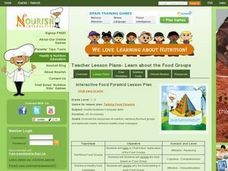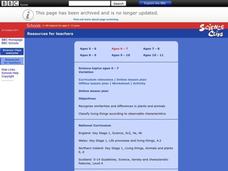Curated OER
Interactive Food Pyramid
Students participate in the game, "Talking Food Pyramid." For this nutrition lesson, students recognize the organization of foods in to five groups. Students conclude by physically classifying a selection of foods in two groups.
Curated OER
Science Excursion: Cover Mapping Land
Students study remotely sensed images and topographic maps to classify land cover types in their watershed area. They take samples in the watershed area to interpret the images.
Curated OER
Fossils-Where Should We Place Archaeopteryx?
Students explore an interactive computer activity that provides the opportunity to look at features of various groups of animals and determine where an extinct organism might be classified.
Curated OER
Five Senses-Introduction
Students explore the parts of the body that are used to develop the five senses. They conduct a nature walk. Students identify the things they see, hear, smell, and touch. They create a graphic organizer to organize their answers.
Curated OER
Investigating Earth's Materials
First graders compare and contrast water from different sources. After collecting water from various sources, 1st graders create a list of observable properties of the water. Students then pour the water into a filter and observe the...
Curated OER
Animals That Fly or Do Not Fly
Students create a chart and classify animals according to if they can or cannot fly. They find and cut out pictures of the animals and glue them in the correct place on the chart.
Curated OER
Variation
Learners participate in an online lesson to reinforce the similarities and differences in plants and animals. They classify living things according to observable characteristics.
Curated OER
Charles Darwin's Hardware Shop
Students construct an evolutionary tree representing specialization, diversity, and selection using easily obtained materials. They use at least twenty pieces of hardware to classify then develop "evolutionary" relationships between the...
Curated OER
Compiling and Weighing Evidence
In this evidence activity, students read about how scientific theories are developed and how evidence is gathered to support the theory. This activity has 2 graphic organizers and 2 short answer questions.
Curated OER
Sorting Into Two Groups
Here is a way for your charges to sort pictures of children into 2 groups and put a title for each group. In this classification lesson plan, learners explain why they chose to separate the children the way they did.
Curated OER
Newspapers
Students work together in pairs to classify types of information that can be found in a newspaper and where to find them. They examine the contents of several newspapers and discuss the paper's organization.
Curated OER
Insect Biology and Ecology: A Primer
Pupils explore insects and closely related organisms. They examine the growth and development of a lady beetle. Students classify insects and organize them. They investigate pest management.
Curated OER
Amphibian Features - Frog Dissection
Seventh graders examine the physical features of an amphibian. In this investigative lesson students compare and contrast the anatomy of a frog to a human.
Curated OER
Sorting Into Predetermined Groups
Sort pictures of items into categories of at school and at the grocery store in a classification lesson plan. Kindergartners start by sorting pictures into categories of in the sky and in the ocean. Use the lesson plan for any story or...
Curated OER
Lesson 3: SortingInformation into Predetermined Categories
Second graders sort items into predetermined categories. In this sorting activity, 2nd graders learn the meaning of the word squirt before listening to a reading of the book, Splish! Splash! Animal Baths by April Pulley Sayre. They...
Curated OER
Answering a Research Question
Students explore beginning research skills. In this nonfiction comprehension and research lesson, students generate possible research questions to answer when given the book title of Animals of the Sea and Shore by Ann O. Squire....
Read Works
Writing a Research Report
Transfer information from an outline into a well-developed research report. Using an already-written outline, model how to write an introductory paragraph and a body paragraph. Work through the conclusion as a class before allowing time...
Curated OER
Fungi - Review and Reinforce
Diagrams of possible fungi life cycles are printed on the worksheet for biology pupils to evaluate. Short-answer questions ask them to explain what a fungus is, how it obtains food, and what would happen if they ceased to exist. The...
Curated OER
All About Seeds!
How do fruits relate to flowers and seeds? Identify the seeds and their purpose with a coloring activity for kindergartners. Once they color the seeds of apples, bananas, and peas (among others), kids get hands-on experience with bean...
Curated OER
Sorting into Three Groups
First graders discuss categorizing items into different groups. In this language arts lesson, 1st graders read a story, chart three categories from the book and describe examples from the book that fit in each category.
Curated OER
What Should You Know about Classification?
Many learners have a tough time picking out pertinent information from a text or in class. Sometimes, all it takes is a study/reading guide to show them the way. The worksheet here focuses on taxonomy and classification, including...
Curated OER
Classification of Animals
Middle schoolers identify observable features of eight dinosaurs and create a sorting chart using SMART Notebook on a SMART Board (or, in case you do not have a SMART Board, a chalk or dry-erase board).
Curated OER
The Origin of Life
In this origin of life worksheet, students write answers to five questions. They describe characteristics of the first life forms and how scientists believe oxygen accumulated in the Earth's atmosphere.
Curated OER
How Do People Get Energy?
In this food energy instructional activity, students will write in examples of different foods that fit into the four food groups: grains, protein, fruits and vegetables, and milk products.

























